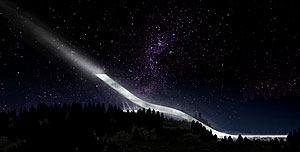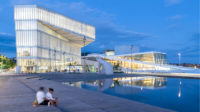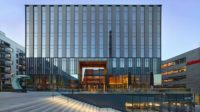Since dissolving the avant-garde Copenhagen architecture firm PLOT in 2006, former partners Julien De Smedt and Bjarke Ingels have launched individual practices with grandiose, statement-making visions. Considering how to add new housing in the middle of already-crowded Copenhagen, for example, Ingels’s firm Bjarke Ingels Group, or BIG, decided that a local sports field could be surrounded by a giant wall containing 5,000 apartments—an unsolicited idea that the municipality now intends to realize. De Smedt, too, has thrilled potential clients. His studio, JDS, recently won a competition to redesign the Holmenkollen ski jump in Oslo.


Images courtesy JDS
Julien De Smedt won a competition to redesign the Holmenkollen ski jump in Oslo (top). At night, a focused beam of white light will project from a viewing platform at the jump’s apex to suggest that Holmenkollen stretches infinitely to the sky (above).
Norwegians invented ski jumping in the early 1860s, and since 1892 they have held annual competitions at Holmenkollen. In order to host contests including the 1952 Olympic Games and the Nordic World Championships of 1966 and 1982, the facility has been renovated or rebuilt 18 times. Preparing for the 2011 Nordic World Championships, the municipality of Oslo promised to construct a larger ski jump with a 119-meter calculation point to replace Holmenkollen; this K119 project would enlarge the facility according to updated International Ski Federation regulations. A jury chose De Smedt’s proposal over 103 other submissions in September, and despite a rocky start that threatened the design from being realized, JDS will submit a final concept this week.
From a distance, the JDS design resembles a giant rectilinear bar, its tall sides giving the sense that the jump is an enclosed volume. This milky white facade runs continuously from the top of the slope to the landing hill and extends to encompass spectator stands, which also protects athletes and onlookers from cross winds. The top of the jump is incised horizontally to create a viewing platform. Perhaps the design’s most striking element, de Smedt’s proposal for Holmenkollen includes an illumination plan that amplifies the jump’s iconic place on the Oslo skyline. At night, a focused beam of white light, practically indistinguishable from the structure, will project from the viewing platform to suggest that Holmenkollen stretches infinitely to the sky.
In December, it seemed like it would be lights out for Holmenkollen when concerns about how the $175 million total budget would be distributed—and what De Smedt cites as government officials’ fear of bold design—threatened to abort the JDS scheme. De Smedt went on a self-proclaimed “media rampage” to save the commission, including the launch of the online petition holmenkollenfyr.com, which has collected more than 1,300 signatures.
De Smedt says that while his blitz appears to be working, he is making some concessions in order to keep the project alive. The existing Holmenkollen arena, which hosts cross-country and other events, will be reused, for example, and De Smedt expects the size of the jump to decrease slightly, probably to a K118 (or a 118-meter calculation point). He hopes that the project will receive a green light by Easter.





Post a comment to this article
Report Abusive Comment